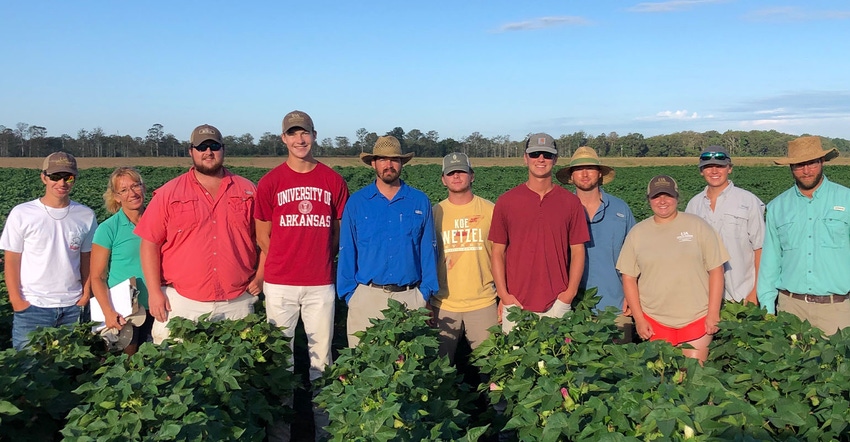
Tarnished plant bug is the number one insect pest of cotton in Arkansas. It is important to have an insecticide that is both effective at controlling the pest and does not hurt your wallet.
Adam Whitfield, a University of Arkansas student, presented research during the online ACPA Conference on the efficacy of selected insecticides for controlling tarnished plant bug, Lygus lineolaris, in Arkansas.
"Our growers in Arkansas are typically going to have to spray four to six times per year for tarnish plant bug," Whitfield said. "It becomes costly over the season if you have to spray multiple times, so we're looking for insecticides that are fast-acting as well as having good residual control over a long period of time to lower the number of necessary sprays."
Plant bug damage
Tarnished plant bug is a perennial pest, which likes wild hosts such as those found in ditch banks and field edges.
"The damage these pests leave behind is mainly feeding on squares, blooms, and bolls," he said. "Looking at a boll with plant bug damage, it has dark spots on the outside, and when you crack open the boll, you will see these yellow tag marks on the fleshy part of the white fruit. Next, looking at the bloom, you can tell by how it starts to look withered. They are also dirty orange and brown on the inside like a typical dirty bloom.
"The squares start to wither, die, and fall off the plant. If you see squares on the ground a lot as you're walking through plots is a good indication of plant bug damage. Squares will flare, start dying, and falling off. A good test for looking at squares is if you can flick it and it falls right off that is a sign that plant bugs have fed on the square."
Control and thresholds
The current threshold is three plant bugs per five-row feet. This is a regional threshold developed in the Midsouth by University entomologists.
"You would want to lower your threshold to two plant bugs per five-row feet if you have a problematic field," Whitfield said. "If you have a history of plant bugs or if you have a bad stand or plant damage, you need to reduce the threshold for plant bugs to ensure you're still getting as much as you can out of your crop when it goes to harvest."
Whitfield suggests taking at least two drop cloth samples in different parts of a field.
"If you take only one, you might get into a hotspot, which isn't a good representation of your field as a whole," he said.
For cultural control, try to plant early to avoid the pest population that comes in the latter part of the growing season.
"Also, you need to keep the field edges clean as well as the ditch banks to control the wild hosts," he said. "You can do this, of course, by using a bush hog around the field and cleaning up the ditch banks, so the plant bugs aren't going back and forth in the field or on the crop."

Field scouting and treatments
Scouting the fields regularly during the growing season and shaking the plants over a black or dark-colored shake sheet can help determine a plant bug problem before it gets out of hand.
"You need to get out there and get on your hands and knees to look," Whitfield said. "It is tempting to drive by and look out the windshield and say it looks good, but you need to get in the crop and look at it closely.
"Our team's objectives were to evaluate the efficacy of available insecticides. All the treatments we used were insecticides on our current recommended list. We wanted to make sure we were still using the correct recommendations as well as determine if there are any issues with insecticide resistance. We wanted to make sure we are using quality treatments, which increase our control of tarnish plant bugs."
The team started with an untreated check to compare the treatments. The treatments used were Transform at 1.5 ounces per acre, Centric at 2 ounces per acre, Vydate at 12.8 ounces per acre, acephate at 0.77 pounds per acre, and another acephate treatment tank-mixed with bifenthrin (Brigade) at 6 ounces per acre. The last four treatments were Bidrin at 6 ounces per acre, Couraze Max at 1.9 ounces per acre, Carbine at 2.85 ounces per acre, and Diamond at 9 ounces per acre.
Methods, materials, and results
Their plot sizes were four rows at about 12.5 feet by 50 feet.
"It's a pretty good representation, so we can get in there and check them throughout the season," Whitfield said. "We use a two-and-a-half-foot drop cloth and took two samples per plot for a total of 10-row feet per plot, which means our threshold will be six plant bugs per 10-row feet."
For all spray applications, a Mudmaster was used.
"As far as timing, we wanted to treat once our threshold had been met of six tarnished plant bugs per 10-row feet," he said. "Once we hit the threshold, we started our first application. Then we would come in seven days later and make a second application.
"We went in four days after our first application, and our untreated check was significantly different from all of our other treatments. It was up about 23 plant bugs per 10-row feet. All of our treatments did show signs of control and did well overall, but some did better than others."
The results showed that Transform, Orthene, Orthene plus bifenthrin, and Bidrin performed consistently better than other insecticides.
"These are our current recommendations and top choices to get the best control of plant bugs," Whitfield said. "On the other hand, Carbine and Couraze Max did not provide adequate control compared to our other plant bug treatments listed."
About the Author(s)
You May Also Like




